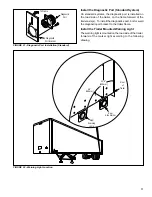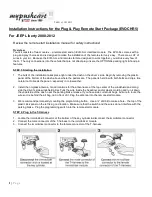
2
Tractor and trailer ABS systems operate independently of
each other. Therefore, systems will work together properly
even if they are not supplied by the same manufacturer.
For information on disassembly, installation, and service of
related axle and brake components, refer to their individual
Bendix
®
Service Manuals.
For assistance in your area call Bendix at 1-800-247-2725
or RoadRanger
®
at 1-800-826-4357.
These ABS controllers and systems were originally
marketed under the Eaton
®
Brand name. For more
information, contact Bendix or refer to your local authorized
Bendix dealer, or RoadRanger
®
.
Power Requirements for ABS
Since March 1998 the trailer wiring systems provide two
sources of power for the antilock system.
The two power sources are:
1. Full-time power (when ignition is on) must be provided
by the tractor. This full-time power source may be
shared with other trailer circuits. The SAE J560 Blue
(AUX) circuit is commonly used as the full-time power
source. In other cases, a separate ISO3731 connector
is provided.
2. Brake light power is provided as a secondary source of
power in cases where an older tractor that does not
provide full-time power is used to operate an ABS
equipped trailer.
The industry requires that the tractor provide at least 10
amps at 12 volts at the trailer end of the SAE J560 or ISO
cable on all ABS power circuits. These specifications meet
TMC RP-137 and are consistent with SAE-2247.
There are no formal requirements. However, suppliers of
Trailer ABS have agreed to provide for proper antilock brake
operation down to a minimum of 8.5 volts (at which time
the warning lamp will activate). A new TMC RP
(Recommended Practice) is being developed which
recommends that trailer manufacturers provide a 1.0 volt
safety margin over the 8.5 volt minimum.
System current requirements will not exceed 0.5 amps per
control unit and three amps per valve.
A-18
™
trailer ABS system modulators have a nominal
resistance of 5.5 ohms and require approximately two amps
to operate. The control unit is designed to power warning
lamps with a typical current of 300mA for trailer mounted
warning lamps and 100mA for cab mounted warning lamps.
Trailer Mounted ABS Warning Light
Rules for the location, color, labeling, intensity and
photometrics for external ABS warning lamps have been
established by the National Highway Transportation Safety
Administration (NHTSA). These requirements were
effective as of March 1, 1998.
Location
The lamp mounting location shall be near the left side rear
of the trailer, no closer than 150 mm (5.9 inches) and not
more than 600 mm (23.6 inches) from the rear red side
marker indicator lamp. (Refer to Figure 22.) On a converter
dolly, the lamp mounting location shall be on a permanent
structure of the dolly at least 375 mm (14 inches) above
the road surface.
Color and Labeling
The malfunction indicator lamp must be yellow in color and
identified with the letters “ABS” to distinguish the lamp from
other yellow side markers. The letters may be on the lens,
on the lens housing, or on the trailer itself, near the lamp.
Intensity and Photometric Requirements
The external ABS malfunction indicator lamp must conform
to SAE-J592 JUN92. Trailers shall use a combination
clearance/side marker lamps marked with a “PC” or “P2”.
These lamps offer a widely diffused beam pattern
throughout a full 180-degree left and right range.
ABS



































